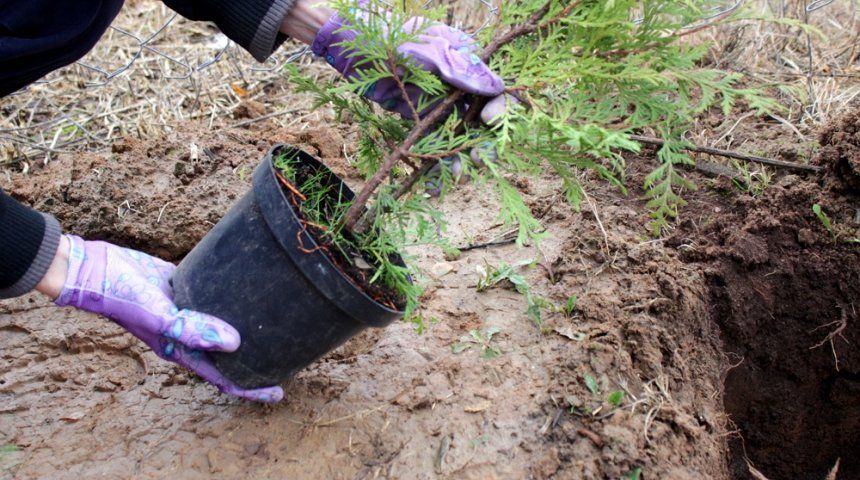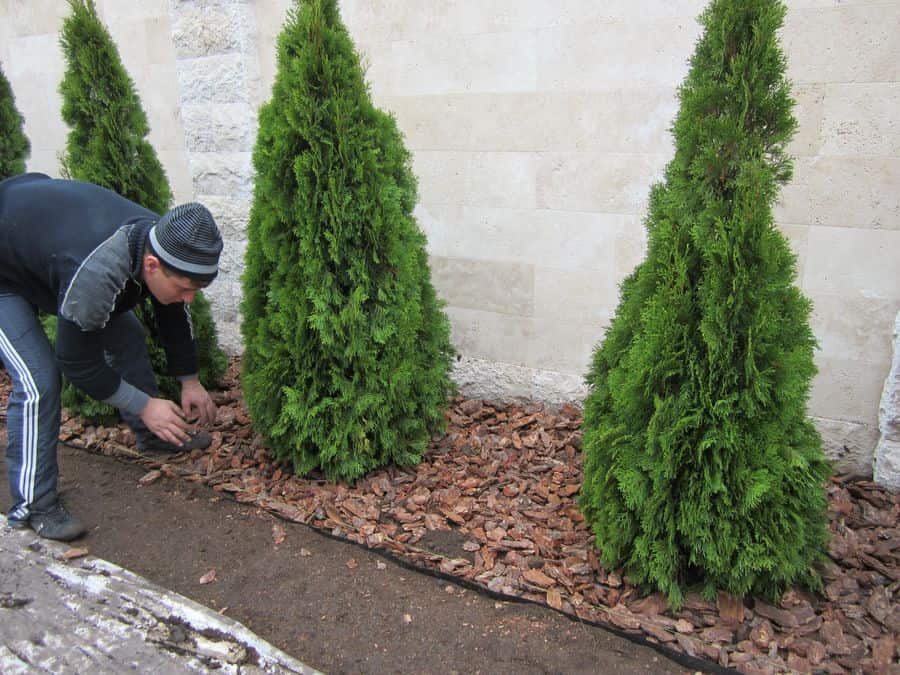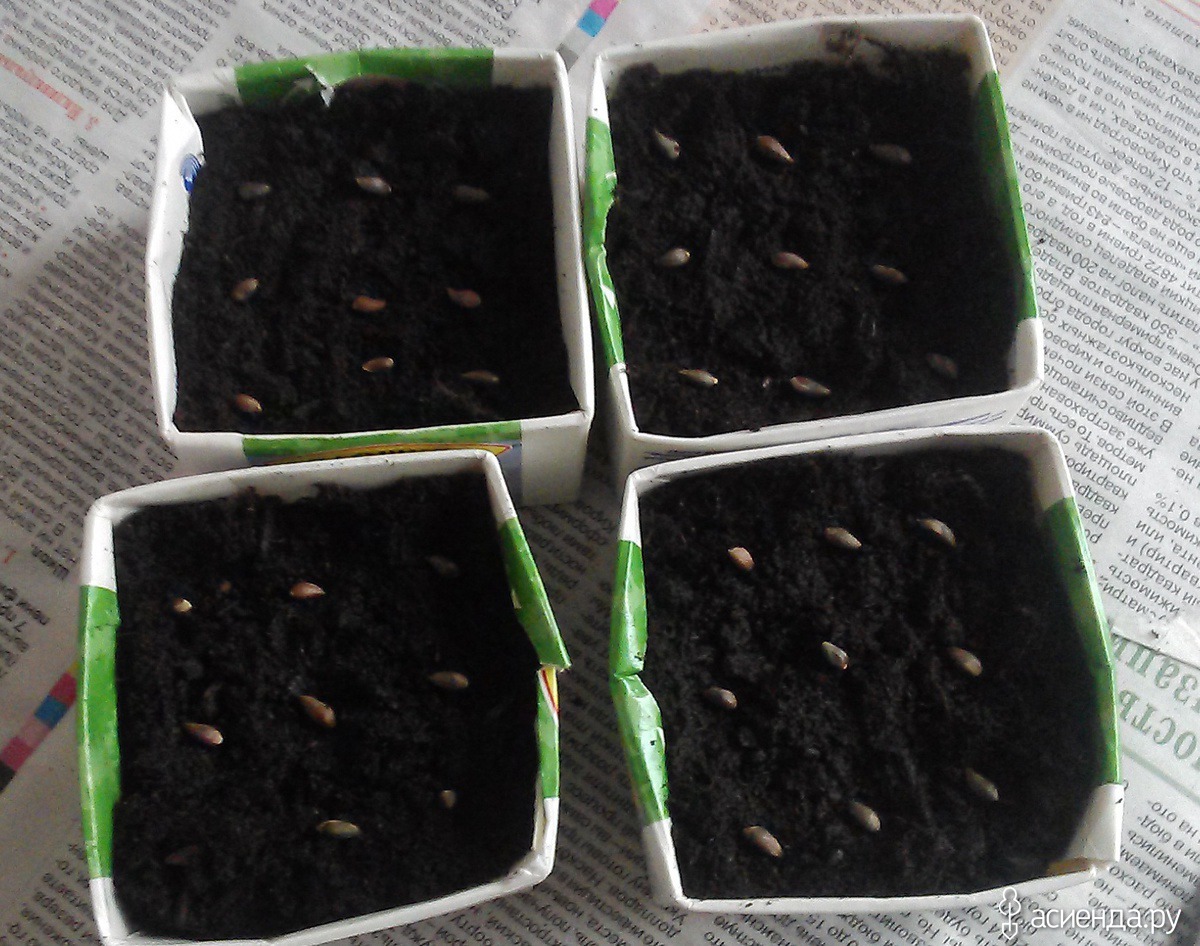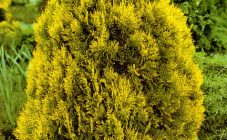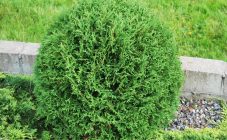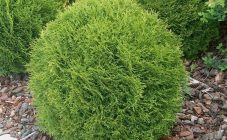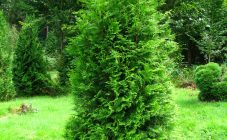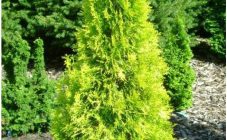Content:
Tui appeared on the Russian market relatively recently. But they immediately won the love of gardeners for their beautiful view, the ability to create various compositions, as well as for the needles that remain on the plant in winter. One of the most spectacular plants - the Yellow Ribbon thuja - is very popular with lovers of green spaces.
Description of culture
Thuja belongs to the Cypress family, is an evergreen tree or shrub. It can grow in one place for 50 years, with proper care - 100 years. Breeders have bred a large number of thuja varieties with a varied palette of shades. Needles are: blue, golden, yellow, all shades of green.
Some representatives of this plant rush up to many meters, and there are dwarf varieties that grow only a few centimeters. The shape of the thuja is varied: spreading, columnar, pyramidal, spherical. The most widespread in horticulture are Eastern thuja, Western thuja, Folded thuja.
Description of thuja Yellow Ribbon
This variety of thuja is bred on the basis of white cedar and is one of its garden forms. His homeland is North America. The crown of the Yellow Ribbon has a conical shape. Its growth rate is low: the shoots grow in height by 10-15 cm, in width - up to 8 cm per year. At the age of 15, the crown height reaches 2 m, the width is 0.8 m.
A distinctive characteristic of this variety: the bright yellow color of its soft, densely caked shoots. Gradually the needles become green, closer to winter - bronze. By autumn, small cones ripen on the thuja. The root system of the plant is shallow, well branched. Yellow Ribbon is wind-resistant and winter-hardy: it can withstand frosts down to -35 ° C.
Conditions for landing
You can plant Thu Yellow in spring or early autumn. With spring planting, the plant will have more time to adapt. With autumn planting, there is a high probability of early frost and the plant may not have time to take root.
This green space is not very demanding on the composition of the soil, but it will grow especially well on a mixture of turf soil with peat and sand. Sandy loam or loam is also allowed. The reaction of the soil should be closer to neutral, but small deviations to an acidic or alkaline environment will not harm the plant.
With a high occurrence of groundwater in the area, it is necessary to make the planting hole 15 cm deeper. At this depth, drainage is laid from fine gravel, expanded clay, sand. The planting area must be protected from drafts. This place should be well lit by the sun, but at noon, it is desirable to have a light partial shade.
Planting an adult plant
The disembarkation process is simple. If the earthen lump on the purchased thuja is too dry, it must first be wetted. Then a landing pit is prepared.
Step-by-step process of planting thuja:
- A hole is dug 1.5 times larger than the earthen koma of thuja. A mixture of earth, sand, peat is poured onto its bottom.
- A seedling is placed in the center of the pit.Its roots are straightened, then the plant is covered with the remaining soil along the root collar.
- The soil around the seedling is compacted and watered.
- The near-trunk circle is covered with peat, sawdust, bark with a layer of 5-7 cm.
When rotting, mulch will serve as a top dressing for thuja. In addition, it will protect the root system from overheating, as well as retain the moisture the plant needs.
Planting by cuttings
Rooting cuttings with their further planting in open ground will allow the gardener to propagate thuja western Yellow Ribbon. This is especially true with the idea of making a hedge out of it, when this will require a lot of seedlings.
The process of planting cuttings step by step:
- Selected cuttings are abruptly cut off from the mother plant along with the heel (piece of bark).
- Their lower part is dipped in any growth stimulant, for example, Kornevin.
- The cuttings are planted shallowly into prepared containers at an angle of 45 °.
- The earth is compacted, moistened.
- Greenhouse conditions are arranged for the seedling: it is covered with plastic wrap.
To prevent infection of the cutting with a fungus, the greenhouse must be constantly ventilated. After a while, the seedlings will take root. They need to be planted in a permanent place after 2 years so that they have more time to strengthen.
Seed planting
Seeds are harvested in autumn, late September or early October. At this time, the cone scales turn brown and begin to open. The seeds are slightly dried, and immediately sown without preparation in shallow grooves. Mulch wakes up from above.
Seedlings will hatch next year. They can be left on this bed for another 1 year, or they can be transplanted into a small school - a special bed for growing. In the third year, plants can be planted in a permanent place. Sowing seeds is also allowed in spring.
You can also sow seeds in seed boxes. For this, the seeds are stratified, soaked in water, planted in prepared boxes. In order for the seeds to germinate faster and more amicably, it is necessary to arrange a mini-greenhouse. It needs to be ventilated periodically.
In spring, seedlings dive into another box or small pots. A year later, they are dived again into larger pots. In the third year, the seedlings take up a permanent place in the garden.
Care
In order for the Thuja Yellow Ribbon to grow well, it needs regular attention. Without leaving, the needles will fade, a lot of cones will form on the plant, and this will not have a very good effect on the decorativeness of the thuja.
Watering should be weekly. In dry time, 2 times a week, and sprinkling of thuja will not be superfluous. After each watering, the soil around the plant is loosened. Weeds are removed, taking away nutrients from the tree. Pruning of old, broken, diseased branches is carried out regularly.
Top dressing is done in early spring with nitrogen fertilizers to build up fluffy needles. At the end of spring, fertilizing with complex fertilizers is applied. At the end of summer, potassium and phosphorus are used. Plants are not fed in autumn: they can release young shoots that will freeze in winter.
Diseases and pests
Any plant can get sick or be attacked by pests. This comes from improper care, weather conditions. Let's consider the most harmful misfortunes that can hit thuja.
- Phytophthora. This is a fungus that settles on the root system and then attacks the entire tree. The disease occurs due to waterlogging of the soil. There is no cure. The plant is dug up and destroyed. Then the soil is spilled with an antifungal solution.
- Mulberry mushroom. The defeat of thuja occurs through various injuries, as well as dried knots. Growths form on the tissues of the tree. They, as well as all affected parts of the thuja, must be cut off. The wounds are cleaned, covered with garden varnish.Thuja is sprayed with copper-containing preparations.
- Weevils. They feed on thuja bark, and their larvae attack the roots. The tips of the branches turn brown. These pests appear in excessively acidic and moist soil. To destroy them, insecticides are used, the soil wakes up with wood ash or lime.
- Spider mite. Appears with excessive dryness, entangling the entire plant with cobwebs. Even if you just sprinkle, the tick will disappear, since it does not like wet conditions. Additionally, the tree can be treated with acaricides.
The use of thuja in garden design
Thuja western Yellow Ribbon is very popular with gardeners because of its golden needles. Its possibilities when drawing up a landscape project are unlimited. It is planted as a hedge, used as a backdrop for flowering plants, and is also grown alone against the backdrop of a lawn. Thuja look spectacular in tubs near the front doors.
When designing a composition, all plants are planted at the same time. Otherwise, the crown of an adult thuja may not allow a neighboring plant to grow. Hibiscus, lilac, rhododendrons will grow well next to it. A combination of golden thuja needles and green other coniferous or decorative deciduous crops will look beautiful.
The presence of thuja Yellow Ribbon on the site will revive it, make it more attractive. Even one thuja will ennoble the territory, and how much joy the gardener will bring to the observation of the cuttings planted with his own hand: a graceful plant grows from a weak seedling in a few years.


